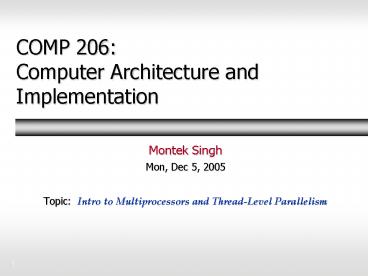COMP 206: Computer Architecture and Implementation - PowerPoint PPT Presentation
Title:
COMP 206: Computer Architecture and Implementation
Description:
single CPU: executing multiple processes ('threads' ... Threads: multiple processes that share code and data ... slows down the execution of individual threads ... – PowerPoint PPT presentation
Number of Views:48
Avg rating:3.0/5.0
Title: COMP 206: Computer Architecture and Implementation
1
COMP 206Computer Architecture and Implementation
- Montek Singh
- Mon, Dec 5, 2005
- Topic Intro to Multiprocessors and Thread-Level
Parallelism
2
Outline
- Motivation
- Multiprocessors
- SISD, SIMD, MIMD, and MISD
- Memory organization
- Communication mechanisms
- Multithreading
- Reading HP3 6.1, 6.3 (snooping), and 6.9
3
Motivation
- Instruction-Level Parallelism (ILP) What all we
have covered so far - simple pipelining
- dynamic scheduling scoreboarding and Tomasulos
alg. - dynamic branch prediction
- multiple-issue architectures superscalar, VLIW
- hardware-based speculation
- compiler techniques and software approaches
- Bottom line There just arent enough
instructions that can actually be executed in
parallel! - instruction issue limit on maximum issue count
- branch prediction imperfect
- registers finite
- functional units limited in number
- data dependencies hard to detect dependencies
via memory
4
So, What do we do?
- Key Idea Increase number of running processes
- multiple processes at a given point in time
- i.e., at the granularity of one (or a few) clock
cycles - not sufficient to have multiple processes at the
OS level! - Two Approaches
- multiple CPUs each executing a distinct
process - Multiprocessors or Parallel Architectures
- single CPU executing multiple processes
(threads) - Multi-threading or Thread-level parallelism
5
Taxonomy of Parallel Architectures
- Flynns Classification
- SISD Single instruction stream, single data
stream - uniprocessor
- SIMD Single instruction stream, multiple data
streams - same instruction executed by multiple processors
- each has its own data memory
- Ex multimedia processors, vector architectures
- MISD Multiple instruction streams, single data
stream - successive functional units operate on the same
stream of data - rarely found in general-purpose commercial
designs - special-purpose stream processors (digital
filters etc.) - MIMD Multiple instruction stream, multiple data
stream - each processor has its own instruction and data
streams - most popular form of parallel processing
- single-user high-performance for one
application - multiprogrammed running many tasks
simultaneously (e.g., servers)
6
Multiprocessor Memory Organization
- Centralized, shared-memory multiprocessor
- usually few processors
- share single memory bus
- use large caches
7
Multiprocessor Memory Organization
- Distributed-memory multiprocessor
- can support large processor counts
- cost-effective way to scale memory bandwidth
- works well if most accesses are to local memory
node - requires interconnection network
- communication between processors becomes more
complicated, slower
8
Multiprocessor Hybrid Organization
- Use distributed-memory organization at top level
- Each node itself may be a shared-memory
multiprocessor (2-8 processors)
9
Communication Mechanisms
- Shared-Memory Communication
- around for a long time, so well understood and
standardized - memory-mapped
- ease of programming when communication patterns
are complex or dynamically varying - better use of bandwidth when items are small
- Problem cache coherence harder
- use Snoopy and other protocols
- Message-Passing Communication
- simpler hardware because keeping caches coherent
is easier - communication is explicit, simpler to understand
- focusses programmer attention on communication
- synchronization naturally associated with
communication - fewer errors due to incorrect synchronization
10
Multithreading
- Threads multiple processes that share code and
data (and much of their address space) - recently, the term has come to include processes
that may run on different processors and even
have disjoint address spaces, as long as they
share the code - Multithreading exploit thread-level parallelism
within a processor - fine-grain multithreading
- switch between threads on each instruction!
- coarse-grain multithreading
- switch to a different thread only if current
thread has a costly stall - E.g., switch only on a level-2 cache miss
11
Multithreading
- Fine-grain multithreading
- switch between threads on each instruction!
- multiple threads executed in interleaved manner
- interleaving is usually round-robin
- CPU must be capable of switching threads on every
cycle! - fast, frequent switches
- main disadvantage
- slows down the execution of individual threads
- that is, traded off latency for better throughput
12
Multithreading
- Coarse-grain multithreading
- switch only if current thread has a costly stall
- E.g., level-2 cache miss
- can accommodate slightly costlier switches
- less likely to slow down an individual thread
- a thread is switched off only when it has a
costly stall - main disadvantage
- limited in ability to overcome throughput losses
- shorter stalls are ignored, and there may be
plenty of those - issues instructions from a single thread
- every switch involves emptying and restarting the
instruction pipeline
13
Simultaneous Multithreading (SMT)
- Example new Pentium with Hyperthreading
- Key Idea Exploit ILP across multiple threads!
- i.e., convert thread-level parallelism into more
ILP - exploit following features of modern processors
- multiple functional units
- modern processors typically have more functional
units available than a single thread can utilize - register renaming and dynamic scheduling
- multiple instructions from independent threads
can co-exist and co-execute!
14
SMT Illustration (Fig. 6.44 HP3)
- A superscalar processor with no multithreading
- A superscalar processor with coarse-grain
multithreading - A superscalar processor with fine-grain
multithreading - A superscalar processor with simultaneous
multithreading (SMT)
15
SMT Design Challenges
- Dealing with a large register file
- needed to hold multiple contexts
- Maintaining low overhead on clock cycle
- fast instruction issue choosing what to issue
- instruction commit choosing what to commit
- keeping cache conflicts within acceptable bounds































